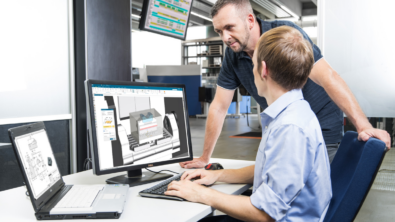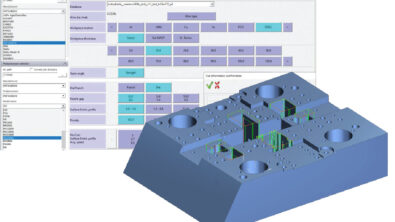The Evolution of Tool Path Design (Part 1)

The primary purpose of modern Computer Aided Machining (CAM) programs is to create efficient tool paths for Computer Numerical Control (CNC) machining. Since machining is a subtractive process, there are at least three measures of tool path efficiency:
- The rate at which material is removed (also known as Material Removal Rate or MRR).
- The overall time required to perform the material removal.
- Tool life.
Computer software engineers have combined with manufacturing experts to create more efficient tool paths over time. The initial CAM tool paths were simply computerized versions of manual tool paths: Zig and Zig-Zag. These motions mimicked the ability of a machinist to feed the table of a manual mill.
Zig signifies one direction cutting. To accomplish this, there are lifts and re-engage motions after every cutting pass. In the pictures below, the light blue color represents cutting passes, while red passes indicate rapid traverse motion, and green represents stepover moves from one cutting pass to another. All pictures are the Siemens NX CAM application.
As you can see from all the red (rapid) moves, Zig takes extra time to retract and reposition for each cut.
Zig-Zag eliminates much of the wasted motion at the expense of switching from one-directional milling to two-direction milling (which can be hard on some cutting tools).
Zig and Zig-Zag both do a great job of material removal as long as there are no obstacles. They are not as good for pocketing or working around obstacles. To demonstrate that, this next image shows a Zig-Zag path inside of an irregular-shaped pocket. The second image shows material that is left uncut.
Both zig and zig-zag cutting are still used frequently today. They are efficient methods of removing layers of material from boxy shapes – think milling planar surfaces. Some CAM software packages allow the zig-zag tool path to be applied to 3D shapes (generally with a ball endmill). Using this cutting strategy on non-planar surfaces has problems. I will discuss those problems in a future post.
In my next blog post, I will explore newer tool path strategies for removing material from planar surfaces.
Thanks for reading.
About the Author
 | Jim has a Master’s degree in Business Administration from the University of Central Missouri. He has over 30 years of experience in the manufacturing industry, and over 25 years of experience in the CAD/CAM field. He serves as Field Support for Siemens PLM CAM products. Prior to his current role, he held stints as CNC Programmer, CAD/CAM Department Manager, CAD/CAM instructor, and Project Coordinator for Siemens PLM CAM software development. |








